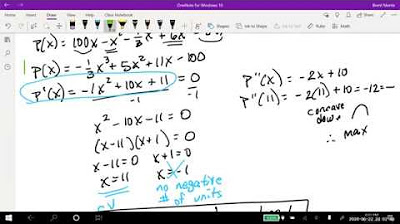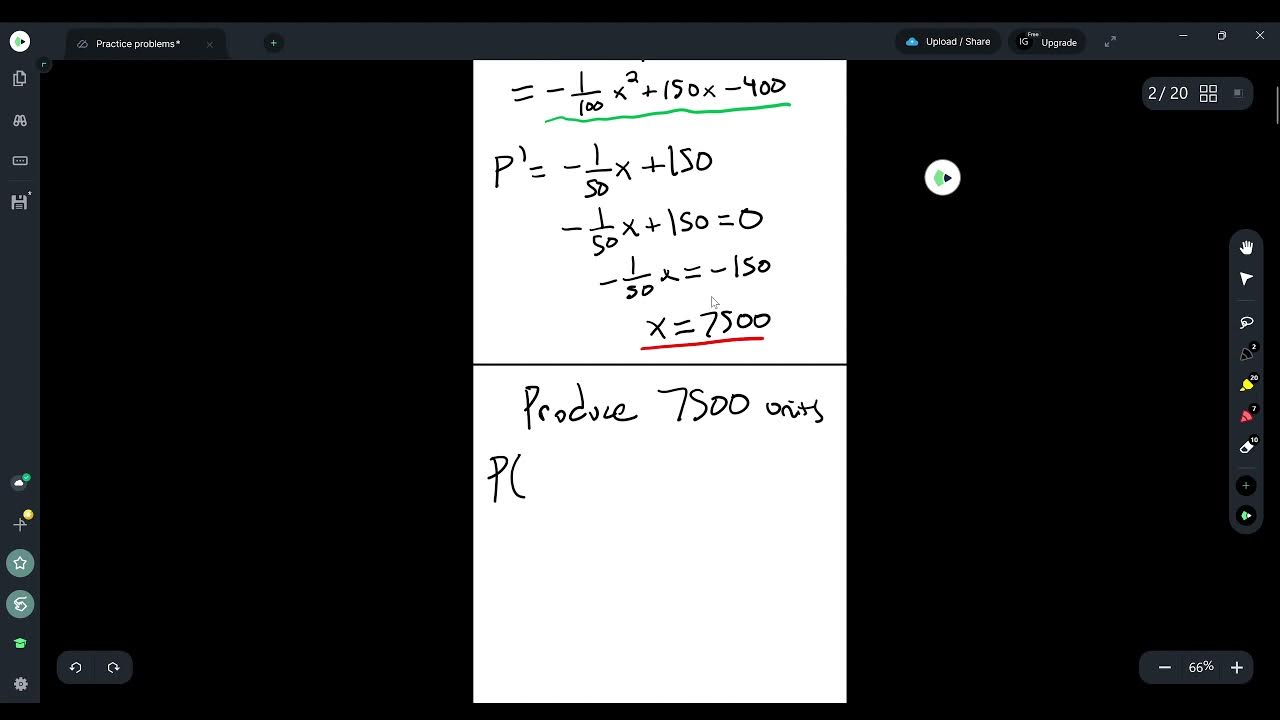Can You Pass This Excel Interview Test?
TLDRThe video script outlines an Excel interview test with four questions of increasing difficulty. It begins with highlighting the 10 lowest orders in red using conditional formatting, moves on to using an IF statement to accept or reject projects based on revenue and profit criteria, tackles an optimization problem to determine the number of shirts needed to reach a profit target with Goal Seek, and finally, it involves using SUMIFS and XLOOKUP formulas to calculate the revenue for France across specific months. The video also promotes an Excel course for business and finance applications.
Takeaways
- 🎯 The first task involves using conditional formatting to highlight the 10 lowest orders in red.
- 📊 For the second question, an IF statement with AND logic is used to determine whether to accept or reject projects based on minimum revenue and profit requirements.
- 💡 The third question requires optimizing the number of shirts to sell to reach a $5,000 profit target, using Excel's Goal Seek tool to find the required quantity.
- 📈 The final challenge involves using both SUMIFS and XLOOKUP formulas to calculate the revenue for France in specific months, demonstrating advanced Excel functions.
- 🔧 The video emphasizes practical application of Excel skills, suggesting real-world scenarios like financial modeling and data cleaning.
- 🌐 The course mentioned offers case studies and opportunities to interact with instructors for additional learning support.
- 📚 The hiring manager's approval is crucial in the interview process, indicating the importance of accuracy and efficiency in Excel tasks.
- 🤝 Collaboration and communication with team members, such as the hiring manager, is highlighted as a valuable skill during the problem-solving process.
- 🔢 Attention to detail is essential, as seen in the need to round up the number of shirts to sell to meet the profit target, avoiding selling fractions of a shirt.
- 🚀 The video encourages continuous learning and improvement in Excel skills, with resources available for further development.
Q & A
How to highlight the 10 lowest orders in Excel?
-To highlight the 10 lowest orders, use the 'Conditional Formatting' feature, select 'Top/Bottom Rules', and choose 'Bottom 10 Items'. Set the format to red and apply it to the range of order values.
What is the purpose of the AND function in the Excel formula presented in the script?
-The AND function is used to ensure that both conditions, revenue greater than or equal to 500,000 and profit greater than or equal to 25,000, must be met for a project to be accepted.
How does one fill the orange area in the Excel sheet based on minimum requirements?
-The orange area is filled using an 'IF' statement that checks if both the revenue and profit meet the minimum requirements. If both conditions are true, the project is 'Accepted'; otherwise, it is 'Rejected'.
What is the objective of Question 3 in the Excel interview test?
-The objective of Question 3 is to determine the number of shirts that need to be sold to reach a profit of five thousand dollars, considering a fixed cost and variable cost per shirt.
How is the 'Goal Seek' tool utilized in Excel to solve the optimization problem?
-The 'Goal Seek' tool is used by setting the desired profit ($5,000) and changing the 'Units Sold' cell to find the quantity that achieves the target profit. The tool adjusts the input to meet the set goal.
What is the significance of using the ROUND UP function in the solution to Question 3?
-The ROUND UP function is used to ensure that the number of shirts sold is a whole number, as selling a fraction of a shirt is not practical. It rounds up the calculated units to the nearest whole number.
How to calculate the revenue for France in each month using two different formulas?
-The first formula uses 'SUMIFS' to sum the revenue for France in specific months. The second formula uses 'XLOOKUP' with two criteria: one for the country (France) and another for the month (January 2023).
Why is the XLOOKUP formula more complex in this scenario compared to the SUMIFS formula?
-The XLOOKUP formula is more complex because it needs to handle two separate criteria (country and month) and dynamically adjust to different months while keeping the country criterion fixed.
What is the role of the ampersand (&) symbol in the XLOOKUP formula?
-The ampersand (&) symbol is used to combine criteria in the XLOOKUP formula, allowing for the lookup to return values based on both the country (France) and the month (January, February, March).
How does the video script emphasize the practical application of Excel skills?
-The script emphasizes practical application by presenting real-world scenarios, such as project acceptance based on financial criteria, optimizing profit, and calculating revenues for specific conditions, which are common tasks in business and finance.
What additional resources are suggested for learning more advanced Excel skills?
-The script suggests enrolling in an Excel for business and finance course, which covers theoretical lessons and offers case studies simulating day-to-day work assignments, including financial modeling and data set cleaning.
Outlines
📝 Excel Interview Test Introduction and Question 1
The video script begins with an introduction to an Excel interview test, where the hiring manager presents four questions of varying difficulty. The first question involves highlighting the 10 lowest orders in red using conditional formatting. The applicant is instructed to use Ctrl+Shift+Down Arrow to select the necessary cells and apply the 'Bottom 10 Items' rule with a red highlight. This task is completed successfully, and the hiring manager approves the solution.
📈 Question 2: Project Acceptance Based on Criteria
The second question requires the use of an IF statement to determine whether projects should be accepted or rejected based on minimum revenue and profit requirements. The applicant uses a formula with AND logical tests to compare the 'Revenue' and 'Profit' columns against the specified thresholds. The formula is structured to return 'Accept' if both conditions are met and 'Reject' otherwise. The solution is applied to the entire data set, and the hiring manager confirms the accuracy of the results.
🔢 Question 3: Shirt Sales Profit Optimization
The third question is an optimization problem aimed at determining the number of shirts to sell to reach a $5,000 profit. The applicant uses assumptions for price per shirt, cost per shirt, and fixed costs to calculate profit. The 'Goal Seek' tool in Excel is then employed to find the quantity of shirts that would yield the target profit. The hiring manager suggests rounding up to a whole number, resulting in 931 units to be sold for the desired profit.
📊 Question 4: Advanced Revenue Calculation for France
The final and most challenging question involves using two different formulas to calculate the revenue for France in each month. The applicant first attempts a SUMIFS formula, specifying criteria for the country and the month of January. A second formula using XLOOKUP is then introduced, which requires adjusting the lookup criteria to dynamically match the country and month across the dataset. The solution is successfully implemented, and the hiring manager is impressed with the applicant's ability to navigate complex Excel functions.
Mindmap
Keywords
💡Excel Interview Test
💡Conditional Formatting
💡IF Statement
💡GoldSeek
💡SUMIFS
💡XLOOKUP
💡Data Analysis
💡Formulas
💡Optimization Problem
💡What-If Analysis
💡Revenue Calculation
Highlights
The hiring manager provides an Excel interview test with four questions of varying difficulty.
Question one involves highlighting the 10 lowest orders in red using conditional formatting.
For question two, applicants must use an IF statement to accept or reject projects based on minimum revenue and profit requirements.
The third question is an optimization problem, calculating the number of shirts to sell to reach a $5,000 profit target.
The final question requires using two different formulas to find the revenue for France in each month.
The video offers a free Excel file for practice, encouraging interactive learning.
The Excel for business and finance course is mentioned, emphasizing real-world applications and case studies.
Instructor support is available through a discussions forum for those taking the course.
The video description contains a link for those interested in downloading the Kimi Chat app.
The hiring manager intervenes to suggest using Excel's Goal Seek tool for the optimization problem.
The SUMIFS formula is introduced to calculate the revenue for France in January 2023.
The XLOOKUP formula is used to find the revenue for France, with an additional criterion for the month.
The video demonstrates the use of CTRL+SHIFT+DOWN arrow to select a range of cells in Excel.
Locking cells with F4 is shown to ensure formulas can be dragged down without altering the reference.
The video showcases the use of the ROUND UP function to adjust the number of units for profit calculations.
The video concludes with the applicant successfully completing the Excel interview test.
Transcripts
5.0 / 5 (0 votes)
Thanks for rating:





